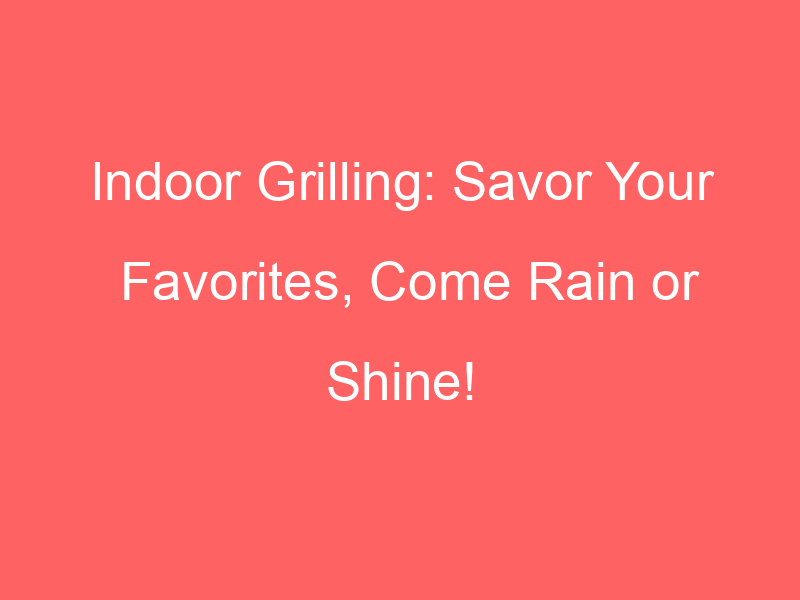Introduction to Indoor Grilling
Grilling is a beloved cooking method for many, often associated with sunny outdoor gatherings and deliciously charred food. But what if you could enjoy the same flavors and textures within the comfort of your own kitchen? Welcome to the world of indoor grilling!
- Understanding the concept of indoor grilling
- Benefits of grilling indoors
Indoor grilling is a cooking method that allows you to grill food inside your home, using special equipment designed for indoor use. It’s a fantastic way to enjoy your favorite grilled dishes, regardless of the weather outside. Indoor grills can be standalone appliances, stovetop pans, or even built into your oven. They are designed to mimic the high, direct heat of an outdoor grill, but in a more controlled and smoke-free environment.
There are numerous benefits to grilling indoors. First and foremost, it allows you to grill year-round, no matter the weather. Rain, snow, or extreme heat won’t stop you from enjoying a juicy grilled steak or a batch of smoky grilled vegetables. Indoor grilling also offers a healthier cooking option as it often requires less oil and the excess fat drips away from the food. Plus, it’s a great way to bring the outdoor grilling experience indoors, especially for those living in apartments or places with limited outdoor space.
Whether you’re a seasoned grill master or a beginner, indoor grilling can open up a whole new world of culinary possibilities. So, let’s dive deeper into the techniques, tips, and recipes that will help you master the art of indoor grilling. Stay tuned!
Indoor Grilling Techniques
Grilling is not just an outdoor activity. With the right techniques, you can enjoy the flavors of grilled food right in your kitchen. Here are some popular indoor grilling methods that you can try.
-
Using an Indoor Grill
An indoor grill is a great tool for grilling indoors. It’s designed to mimic the effects of an outdoor grill, but without the smoke and the need for charcoal or gas. To use an indoor grill, preheat it for a few minutes. Once it’s hot, place your food on the grill and close the lid. The heat from the grill will cook the food and create those classic grill marks. Remember to turn your food halfway through to ensure it cooks evenly.
-
Grilling on the Stove
You can also grill on your stove using a grill pan. This pan has raised ridges that simulate the grates on a grill. To grill on the stove, preheat your grill pan over medium heat. Once it’s hot, add your food. You’ll need to flip it halfway through cooking to get grill marks on both sides. Be sure to use a spatula or tongs to turn your food, as using a fork can cause juices to escape and make your food dry.
-
Oven Grilling
Oven grilling, also known as broiling, is another indoor grilling method. To grill in the oven, you’ll need to use your oven’s broiler. Place your food on a broiler pan and insert it into the oven. The heat from the broiler will cook the food and give it a grilled flavor. Be sure to watch your food closely, as it can burn quickly under the broiler’s intense heat. Also, remember to flip your food halfway through cooking to ensure it grills evenly.
Each of these indoor grilling techniques can give your food a delicious grilled flavor, even when you can’t grill outdoors. So, don’t let the weather stop you from enjoying your favorite grilled foods. Try these techniques and discover the joys of indoor grilling.
Grilling Indoors Tips
Indoor grilling can be a delightful experience, especially when you have the right tips to guide you. Here are some essential tips to help you grill indoors like a pro.
- Choosing the Right Equipment
- Proper Ventilation
- Temperature Control
- Cleaning and Maintenance
Choosing the right equipment is the first step towards successful indoor grilling. There are various types of indoor grills available in the market, such as contact grills, open grills, and grill pans. Contact grills are ideal for sandwiches and burgers, while open grills and grill pans are perfect for steaks and vegetables. Always choose a grill that fits your cooking needs and kitchen space.
Proper ventilation is crucial when grilling indoors to avoid smoke buildup. Ensure you have an effective exhaust system or open windows to let out the smoke. Using a fan can also help circulate the air and reduce smoke.
Temperature control is key to achieving perfect grill marks and well-cooked food. Most indoor grills come with adjustable temperature controls. For meat, a higher temperature is usually required, while vegetables and fruits need a lower temperature. Always preheat your grill before cooking to ensure even heat distribution.
Regular cleaning and maintenance of your indoor grill will prolong its lifespan and ensure it functions efficiently. After each use, allow the grill to cool down before cleaning. Use a grill brush to remove food particles and a damp cloth to wipe the surface. Avoid using harsh chemicals that can damage the grill’s surface.
Remember, practice makes perfect. The more you grill, the better you’ll become. So, don’t be afraid to experiment with different recipes and techniques. Happy grilling!
Indoor Grilling Recipes
Indoor grilling is a fantastic way to enjoy your favorite grilled foods, regardless of the weather outside. In this section, we will explore some delicious recipes that you can prepare using an indoor grill. These recipes are not only tasty but also easy to make, ensuring that you can enjoy a grilled meal anytime you want.
Indoor Grill Favorites
There are countless recipes you can try on your indoor grill, but some dishes are universally loved. Here are three of the most popular indoor grilling recipes:
- Grilled Chicken: Grilled chicken is a versatile dish that can be paired with a variety of sides. To prepare, marinate your chicken in your choice of spices for at least an hour. Then, grill each side for 5-7 minutes or until the chicken is cooked through. Serve with a side of grilled vegetables or a fresh salad.
- Grilled Vegetables: Grilled vegetables are a healthy and delicious side dish that can accompany any meal. Simply chop your favorite vegetables, toss them in olive oil and your preferred seasoning, and grill them for about 10 minutes. The result is a flavorful and nutritious addition to your meal.
- Grilled Fish: Grilled fish is a light and flavorful dish that’s perfect for a healthy dinner. Choose a firm fish like salmon or tuna, season it with lemon, garlic, and herbs, and grill it for about 4 minutes on each side. Serve with a side of grilled asparagus and a lemon wedge for a restaurant-quality meal at home.
These are just a few examples of the delicious meals you can prepare on your indoor grill. With a bit of creativity and the right ingredients, the possibilities are endless. So, don’t let the weather stop you from enjoying your favorite grilled foods. With these indoor grilling recipes, you can savor the flavors of summer all year round.
Rainy Day Grilling
Don’t let a little rain dampen your grilling spirit! With the right preparation and adaptations, you can enjoy a delicious grilled meal indoors. Here’s how:
- Preparing for Indoor Grilling
- Adapting Outdoor Recipes for Indoor Grilling
Indoor grilling requires a bit of preparation to ensure safety and effectiveness. First, you’ll need an indoor grill. These come in various types, such as stovetop grill pans or electric grills. Make sure your kitchen is well-ventilated to handle the smoke that grilling produces. Open windows or use an exhaust fan if available. Always keep a fire extinguisher nearby for safety.
Next, gather your grilling tools. You’ll need tongs, a spatula, and oven mitts to handle hot food and grill parts. A meat thermometer is also handy to ensure your food is cooked to the correct temperature.
Finally, prepare your food. Marinate your meats or vegetables ahead of time for maximum flavor. Preheat your grill before you start cooking for the best results.
Many of your favorite outdoor grilling recipes can be adapted for indoor grilling. The key is to adjust cooking times and temperatures. Indoor grills may not get as hot as outdoor ones, so you may need to cook your food longer. Use a meat thermometer to ensure your food is cooked thoroughly.
Also, consider the smoke factor. Some foods, like fatty meats, can produce a lot of smoke when grilled. If you’re grilling indoors, you might want to choose leaner cuts of meat or marinate your food in a way that reduces smoke.
Lastly, don’t forget about the sides! Many side dishes you’d cook on an outdoor grill, like corn on the cob or grilled vegetables, can be easily cooked on an indoor grill.
Remember, grilling is not just for sunny days. With a bit of preparation and creativity, you can enjoy delicious grilled meals indoors, rain or shine!
Indoor BBQ Ideas
Indoor barbecuing is a fantastic way to enjoy your favorite grilled foods, regardless of the weather outside. With the right tools and techniques, you can create a BBQ experience that rivals any outdoor cookout. Here are some tips to help you get started.
Indoor Barbecue Tips
Indoor barbecuing requires a slightly different approach than outdoor grilling. Here are some tips to help you achieve the best results:
- Choosing the right sauces and marinades
- Using a grill pan for BBQ
- Creating a BBQ atmosphere indoors
One of the keys to a successful indoor BBQ is the flavor. Sauces and marinades can make a big difference. Try to use sauces and marinades that complement the natural flavors of your meat. For example, a sweet and tangy BBQ sauce works well with pork, while a spicy marinade can add a kick to chicken. Experiment with different combinations to find what you like best.
A grill pan is a must-have tool for indoor BBQ. It allows you to get those beautiful grill marks on your food, just like an outdoor grill. When using a grill pan, make sure to preheat it before adding your food. This will help to sear the outside of your meat, locking in the juices and flavor. Remember to turn on your kitchen’s exhaust fan or open a window to help with ventilation.
Part of the fun of a BBQ is the atmosphere. Even though you’re indoors, you can still create a festive BBQ vibe. Play some upbeat music, set the table with checkered tablecloths, and serve your BBQ dishes on paper plates for an authentic feel. You could even invite your guests to wear their favorite BBQ attire!
With these tips in mind, you’re ready to host your own indoor BBQ. Remember, the most important thing is to have fun and enjoy the delicious food you’ve prepared. Happy grilling!
Grilling in Bad Weather
Grilling is a beloved pastime for many, but bad weather can often put a damper on your plans. However, with the right precautions and knowledge, you can still enjoy a delicious grilled meal even when the weather is less than ideal. Here are some tips on how to grill indoors and ensure food safety during bad weather.
- Precautions to take when grilling indoors
- Ensuring food safety
Grilling indoors is a great alternative when the weather is not cooperating. However, it’s important to take certain precautions to ensure safety. First, never use a charcoal grill indoors as it can cause carbon monoxide poisoning. Always use an indoor grill or your stove’s broiler. Second, ensure proper ventilation. Open windows or use an exhaust fan to clear out any smoke. Lastly, keep a fire extinguisher nearby just in case of any accidental fires.
Food safety is paramount when grilling, especially in bad weather. Here are a few tips to ensure your food is safe to eat. First, always wash your hands before and after handling raw meat. Second, use separate cutting boards for raw and cooked foods to prevent cross-contamination. Third, always cook meat to the recommended internal temperature to kill any harmful bacteria. For example, poultry should be cooked to an internal temperature of 165°F, while steaks and roasts should be cooked to 145°F. Lastly, never leave perishable foods out of the refrigerator for more than two hours.
In conclusion, grilling in bad weather doesn’t have to be a daunting task. With the right precautions and a focus on food safety, you can still enjoy a delicious grilled meal indoors. So, don’t let the rain or snow stop you from enjoying your favorite grilled foods!
| Food | Recommended Internal Temperature |
|---|---|
| Poultry | 165°F |
| Steaks and Roasts | 145°F |
Indoor Grilling Equipment
When it comes to indoor grilling, having the right equipment is crucial. This section will guide you through the different types of indoor grills, essential grilling tools, and how to maintain and care for your equipment.
- Types of Indoor Grills
- Open Grills: These are similar to outdoor grills but are smaller and designed to be used indoors. They provide a real grilling experience and are perfect for grilling meat and vegetables.
- Contact Grills: These grills have two cooking surfaces that press together, making them ideal for sandwiches and paninis. They cook food faster since they heat from both sides.
- Stove Top Grills: These are pans designed to sit on top of your stove’s burners. They’re great for those who have limited space but still want the grilling experience.
- Essential Grilling Tools
- Grill Tongs: These are necessary for turning and moving food around on the grill.
- Grill Brush: This is used to clean the grill after use. It’s important to keep your grill clean to prevent food from sticking and to prolong its life.
- Meat Thermometer: This tool ensures that your meat is cooked to the correct temperature, ensuring both safety and taste.
- Maintenance and Care of Equipment
- Cleaning: Always clean your grill after use to prevent buildup of food particles and grease. This can be done with a grill brush and some warm soapy water.
- Storage: If you’re not using your grill regularly, store it in a cool, dry place to prevent rusting and damage.
- Regular Check-ups: Regularly check your grill for any signs of wear and tear. If you notice any, it’s best to address them immediately to prevent further damage.
There are several types of indoor grills to choose from, each with its unique features and benefits. Here are the most common ones:
Having the right tools can make your grilling experience easier and more enjoyable. Here are some essential grilling tools:
Proper maintenance and care of your grilling equipment can extend its lifespan and improve its performance. Here are some tips:
Grilling indoors can be a fun and delicious experience. With the right equipment and proper care, you can enjoy your favorite grilled foods all year round, regardless of the weather.
Enjoy Grilling Indoors
Grilling isn’t just for the outdoors. You can enjoy the same smoky flavors and juicy results right in the comfort of your own kitchen. Let’s dive into two key aspects of indoor grilling: creating a grilling schedule and experimenting with different recipes.
-
Creating a Grilling Schedule
A grilling schedule is a great way to organize your indoor grilling activities. It helps you plan your meals and ensures you have all the necessary ingredients on hand. Here’s a simple way to create one:
- Decide on the meals you want to grill for the week.
- Make a list of the ingredients you’ll need for each meal.
- Check your pantry and fridge to see what you already have.
- Shop for the remaining ingredients.
- Assign a day and time for each meal.
Remember, a grilling schedule isn’t set in stone. Feel free to adjust it as necessary to accommodate your lifestyle and preferences.
-
Experimenting with Different Recipes
One of the joys of indoor grilling is the opportunity to experiment with different recipes. Whether you’re a fan of classic BBQ chicken or want to try something more exotic like grilled pineapple, the possibilities are endless.
Here are a few tips to get you started:
- Start with simple recipes and gradually try more complex ones.
- Don’t be afraid to mix and match flavors. For example, sweet and spicy can be a winning combination.
- Use a variety of meats and vegetables to keep things interesting.
- Try different marinades and sauces to enhance the flavor of your grilled foods.
Remember, the key to successful grilling is patience and practice. So, don’t be discouraged if your first few attempts don’t turn out as expected. Keep experimenting and you’ll soon be a master of indoor grilling.
Conclusion: Savor Your Favorites, Come Rain or Shine!
As we wrap up this comprehensive guide on indoor grilling, it’s time to reflect on the key takeaways and encourage you to embark on your own indoor grilling journey.
- Recap of indoor grilling benefits and techniques:
- Encouragement to try indoor grilling:
Indoor grilling offers a host of benefits. It allows you to enjoy your favorite grilled dishes all year round, regardless of the weather. It’s also a healthier cooking method as it requires less oil and the grill’s heat helps to melt away excess fat. Techniques such as preheating the grill, using the right tools, and marinating your food can enhance your indoor grilling experience.
If you haven’t tried indoor grilling yet, now is the perfect time. With the knowledge and techniques you’ve learned from this guide, you’re well-equipped to start. Remember, practice makes perfect. So, don’t be discouraged if your first few attempts don’t turn out as expected. Keep experimenting with different recipes and techniques, and soon, you’ll be grilling like a pro. So, go ahead, fire up that indoor grill and savor your favorites, come rain or shine!
“The only real stumbling block is fear of failure. In cooking, you’ve got to have a what-the-hell attitude.” – Julia Child
Happy grilling!






